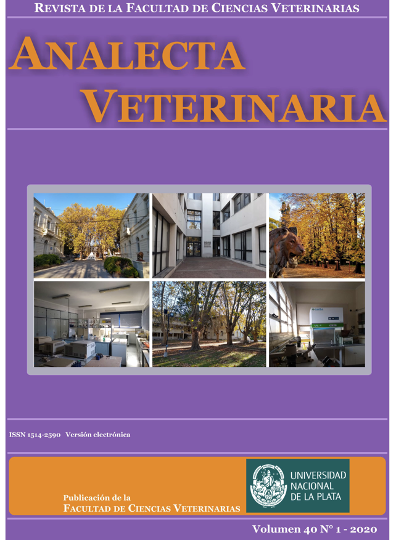Pseudomonas aeruginosa en la otitis externa canina: situación actual
DOI:
https://doi.org/10.24215/15142590e048Palavras-chave:
otitis externa, Pseudomonas aeruginosa, antimicrobianos, PK/PD, caninosResumo
La otitis externa es una enfermedad de presentación frecuente en la práctica diaria. La comprensión de su fisiopatología es importante para su prevención, diagnóstico y tratamiento. El protocolo diagnóstico debe ser estricto, siendo fundamental el rol que cumplen en estos casos el cultivo bacteriano y el antibiograma. Pseudomonas aeruginosaes un microorganismo oportunista e invasor, que constituye en sí mismo un factor perpetuante para las otitis crónicas. Además de sus factores de virulencia y la resistencia intrínseca a múltiples fármacos, forma biopelículas de protección sobre tejidos colonizados y posee gran capacidad para adquirir genes determinantes de resistencia cromosómica y extra cromosómica durante el tratamiento. Los casos crónicos o recurrentes con aislamientos de P. aeruginosa resultan un desafío constante para el veterinario. El oído externo tiene escasa irrigación, por lo cual los antimicrobianos sistémicos no alcanzan concentraciones adecuadas, siendo la terapia tópica la primera elección. El éxito terapéutico evoluciona hacia la aplicación de pautas farmacocinéticas/farmacodinámicas, desde una concepción netamente empírica hasta una concepción cuantitativa, permitiendo describir y simular el efecto de un antibiótico sobre una población bacteriana en función del tiempo, mediante la modelización matemática de los datos experimentales, con objeto de maximizar la eficacia y minimizar fenómenos de resistencia.
Referências
Barnard N, Aiden F. 2017. Pseudomonas otitis in dogs: a general practitioner’s guide to treatment. In Practice 39:386-98. http://dx.doi.org/10.1136/inp.j892
Berthelot P, Grattard F, Mallaval F, Ros A, Lucht F, Pozzetto B. 2005. Épidémiologie dês infections nosocomiales à Pseudomonas aeruginosa, Burkholderia cepacia ET Stenotrophomonas maltophilia. Pathologie Biologie. 53 (6):341-8. https://doi.org/10.1016/j.patbio.2004.09.006
Broglia G, Borrelli S. Enfermedades del oído. En: Brusa M. 2014. Compendio de enfermedades de los caninos y felinos domésticos. Buenos Aires, Editorial Edulp, pp. 396-413.
Buckley L, McEwen N, Nuttall T. 2013. Tris-EDTA significantly enhances antibiotic efficacy against multidrug-resistant P aeruginosa in vitro. Veterinary Dermatology. 24(5):519-e122. https://doi.org/10.1111/vde.12071
Bugden DL. 2013. Identification and antibiotic susceptibility of bacterial isolates from dogs with otitis externa in Australia. Australian Veterinary Journal. 91(1-2):43-6. https://doi.org/10.1111/avj.12007
Buldain D, Buchamer A, Marchetti L, Aliverti F, Borja C, Mestorino N. 2017. Efecto antimicrobiano de la combinación cloxacilina con aceite esencial de Melaleuca armillaris frente a Staphylococcus aureus. Analecta Veterinaria. 37(2):33-9. https://doi.org/10.24215/15142590e014
Buldain D, Buchamer AV, Marchetti ML, Aliverti F, Bandoni A, Mestorino N. 2018. Combination of cloxacillin and essential oil of Melaleuca armillaris as an alternative against Staphylococcus aureus. Veterinary Pharmacology and Toxicology, Frontiers in Veterinary Science.5:177. https://doi.org/10.3389/fvets.2018.00177
Cabot G, Zamorano L, Moyà B, Juan C, Navas A, Blázquez J, Oliver A. 2016. Evolution of Pseudomonas aeruginosa antimicrobial resistance and fitness under low and high mutation rates. Antimicrobiology Agents Chemotherapy 60:1767-78. https://doi.org/10.1128/AAC.02676-15.
Caffier P, Harth W, Mayelzadeh B, Haupt H, Sedlmaier B. 2007. Tacrolimus: a new option in therapy-resistant chronic external otitis. Laryngoscope. 117(6):1046-52. https://doi.org/10.1097/MLG.0b013e31804b1aad
Craig WA. 1998. Pharmacokinetic-pharmacodynamic parameters: rationale for antibiotic use in mice and men. Clinical Infectious Diseases. 26:1-12. https://doi.org/10.1086/516284
Craig WA. 2002. The role of pharmacodynamics in infective treatment of community-acquired pathogens. Advanced Studies in Medicine (Proceeding).2:126-34.
Cole L. 2009. Anatomy and physiology of the canine ear. Veterinary Dermatology. 20, 412-21. https://doi.org/10.1111/j.1365-3164.2009.00849.x
Escribano C, Ordeix L, Pol G, Puigdemont A, Brazis P. 2009. Sensibilidad de Pseudomonas spp. frente a las quinolonas en infecciones óticas y cutáneas en el perro y en el gato. Clínica Veterinaria de Pequeños Animales. 29 (4):203-7.
Gómez Álvarez C, Leal Castro A, Pérez de González M, Navarrete Jiménez M. 2005. Mecanismos de resistencia en Pseudomonas aeruginosa: entendiendo a un peligroso enemigo. Revista de la Facultad de Medicina Universidad Nacional de Colombia. 53 (1):27-34.
Gotthelf L. 2004. Diagnosis and treatment of otitis media in dogs and cats.The Veterinary Clinic of North America.Small Animal Practice. 34(2):469-87. https://doi.org/10.1016/j.cvsm.2003.10.007
Griffin C. 2011.Otitis, lo básico. Proceedings of the Southern European Veterinary Conference &CongresoNacional de AVEPA, Barcelona, España.
Hall JA, Waisglass S, Mathews K, Tait J. 2003. Oral cyclosporin in the treatment of end-stage ear disease: a pilot study.Veterinary Dermatology.14:212.
Hariharan H, Coles M, Poole D, Lund L, Page R. 2006. Update on antimicrobial susceptibilities of bacterial isolates from canine and feline otitis externa. Canadian Veterinary Journal. 47(3):253-5.
Jacobson LS. 2002. Diagnosis and medical treatment of otitis externa in the dog and cat. Journal South African Veterinary Association. 73(4):162-70. https://doi.org/10.4102/jsava.v73i4.581
Kobayashi M, Yoshida T, Takeuchi D, Jones V, Shigematsu K, Herndon D, Suzuki F. 2008. Gr-1+ CD11b+ cells as an accelerator of sepsis stemming from Pseudomonas aeruginosa wound infection in thermally injured mice. Journal Leukocite Biology. 83(6):1354-62. https://doi.org/10.1189/jlb.0807541
Li R, Zhu M, Schentag J. 1999. Achieving an optimal outcome in the treatment of infections: The role of clinical pharmacokinetics and pharmacodynamics of antimicrobials.Clinical Pharmacokinetics. 37:1-16. https://doi.org/10.2165/00003088-199937010-00001.
Lin D, Foley S, Qi Y, Han J, Ji C, Li R, Wu C, Shen J, Wang Y. 2012.Characterization of antimicrobial resistance of Pseudomonas aeruginosa isolated from canine infections. Journal of Applied Microbiology. 113(1):16-23. https://doi.org/10.1111/j.1365-2672.2012.05304.x.
Liu P, Rand K, Obermann B, Derendorf H. 2005. Pharmacokinetic-pharmacodynamic modelling of antibacterial activity of cefpodoxine and cefixime in in vitro kinetic models.International Journal of Antimicrobial Agents. 25(2):120-9. https://doi.org/10.1016/j.ijantimicag.2004.09.012.
Livemore D. 2002. Multiple mechanisms of antimicrobial resistance in Pseudomonas aeruginosa: our worst nightmare? Clinical Infectious Diseases. 34(5):634-40. https://doi.org/10.1086/338782
Mandell GL, Bennett JE, Dolin R. 2012. Mandell, Douglas y Bennett. Enfermedades infecciosas. Principios y práctica. 7º Ed. Barcelona, Elsevier España.
Maruhashi E, São Braz B, NunesT, Pomba C, Belas A, Duarte-Correia JE,Lourenço AM. 2016. Efficacy of medical grade honey in the management of canine otitis externa - a pilot study. Veterinary Dermatology. 27(2):93-e27. https://doi.org/10.1111/vde.12291
Mauldin E, Ness T, Goldschmidt M. 2007.Proliferative and necrotizing otitis externa in four cats. Veterinary Dermatology. 18(5):370-7. https://doi.org/10.1111/j.1365-3164.2007.00614.x.
May ER, Conklin KA, Bernis DA. Antibacterial effect of N‐acetylcysteine on common canine otitis externa isolates. 2016. Veterinary Dermatology 27(3):188-e47. https://doi.org/10.1111/vde.12313.
Mestorino N. 2006. Antibioticoterapia racional de enfermedades respiratorias en pequeños animales. Proceedings 6º Congreso Nacional de AVEACA, Buenos Aires, Argentina,pp 76-87.
Neves R, Makino H, Cruz T, Silveira M, Sousa V, Dutra V, Lima M, Belli C. In vitro and in vivo efficacy of tea tree essential oil for bacterial and yeast ear infections in dogs. 2018. Pesquisa Veterinaria Brasileira. 38(8):1597-607. https://doi.org/10.1590/1678-5150-PVB-5055.
Ngo J, Taminiau B, Aboulaye Fall P, Daube G, Fontaine J. 2018. Ear canal microbiota - a comparison between healthy dogs and atopic dogs without clinical signs of otitis externa.Veterinary Dermatology. 29(5):425-e140. https://doi.org/10.1111/vde.12674.
Nuttall T. 2016. Successful management of otitis externa.In Practice. 38(2):17-21.
Oliveira L, Leite C, Brilhante R, Carvalho C. 2008. Comparative study of the microbial profile from bilateral canine otitis externa.Canadian Veterinary Journal. 49(8):785-8.
Paterson S, Matyskiewicz W. 2018. A study to evaluate the primary causes associated with Pseudomonas otitis in 60 dogs. The Journal of Small Animal Practice. 59:238-42. https://doi.org/10.1111/jsap.12813
Paterson S. 2016a.Discovering the causes of otitis externa.In Practice. 38:7-11. https://doi.org/10.1136/inp.i470.
Paterson S. 2016b.Topical ear treatment, options, indications, and limitations of current therapy.Journal of Small Animal Practice. 57(12):668-78. https://doi.org/10.1111/jsap.12583.
Penna B, Thomé S, Martins R, Martins G, Lilenbaum W. 2011. In vitro antimicrobial resistance of Pseudomonas aeruginosa isolated from canine otitis externa in Rio de Janeiro, Brazil. Brazilian Journal of Microbiology. 42(4):1434-6. https://doi.org/10.1590/S1517-838220110004000027
Petersen A, Walker R, Bowman M, Schott H, Rosser E Jr. 2002. Frequency of isolation and antimicrobial susceptibility patterns of Staphylococcus intermedius and Pseudomonas aeruginosa isolates from canine skin and ear samples over a 6-year period (1992-1997). Journal of American Animal Hospital Association. 38(5): 407-13. https://doi.org/10.5326/0380407
Petrov V, Mihaylov G, Tsachev I, ZhelevG, Marutsov P, Koev K. 2013. Otitis externa in dogs: Microbiology and antimicrobial susceptibility. Revista de Medicina Veterinaria. 164(1):18-22.
Pulido A, Castañeda RS, Linares ML, Mercado MG. 2010. Diagnóstico clínico-microbiológico de otitis externa en caninos de Bogotá – Colombia. Revista MVZ Córdoba. 15(3):2215-22. https://doi.org/10.21897/rmvz.308
Rasamiravaka T, Labtani Q, Duez P, Jaziri M. 2015. The formation of biofilms by Pseudomonas aeruginosa: a review of the natural and synthetic compounds interfering with control mechanisms. BioMed Research International. 2015: 1-17. https://doi.org/10.1155/2015/759348.
Rosychuk R, Luttgen P. Diseases of the ear. En: Ettinger S, Feldman E (eds). 2000. Textbook of veterinary internal medicine.5th ed. Philadelphia, W B Saunders, p. 986-1002.
Rubin J, Walker R, Blickenstaff K, Bodeis-Jones S, Zhao S. 2008. Antimicrobial resistance and genetic characterization of fluoroquinolone resistance of Pseudomonas aeruginosa isolated from canine infections. Veterinary Microbiology. 131(1-2):164-72. https://doi.org/10.1016/j.vetmic.2008.02.018
Sánchez C, Calle E, Falcón P, Pinto J. 2011. Aislamiento bacteriano en casos de otitis canina y su susceptibilidad antibiótica. Revista de Investigación Veterinaria del Perú. 22 (2):161-6.
Saridomichelakis M, Farmaki R, Leontides L, Koutinas A. 2007. Aetiology of canine otitis externa: a retrospectibe study to 100 cases. Veterinary Dermatology. 18(5):341-7. https://doi.org/10.1111/j.1365-3164.2007.00619.x.
Scott D, Miller W, Griffin C. Diseases of eyelids, claws, anal sacs, and ears. En: Scott D, Miller W, Griffin C (eds).2001. Muller & Kirk’s small animal dermatology. 6th ed. Philadelphia, W B Saunders.
Sim J, Khazandi M, Chan W, Trott D, Deo P. 2019. Antimicrobial activity of thyme oil, oregano oil, thymol and carvacrol against sensitive and resistant microbial isolates from dogs with otitis externa. Veterinary Dermatology. 30(6):524-e159. https://doi.org/10.1111/vde.12794.
Song SY, Hyun JE, Kang JH, Hwang CY. 2020. In vitro antibacterial activity of the manuka essential oil from Leptospermum scoparium combined with Tris-EDTA against Gram-negative bacterial isolates from dogs with otitis externa. Veterinary Dermatology. 31(2):81-8. https://doi.org/10.1111/vde.12807
Terziev G, Borissov I. 2017.Prevalence of ear diseases in dogs –A retrospective 5-year clinical study.Bulgarian Journal of Veterinary Medicine. 21(1):76-85. https://doi.org/10.15547/bjvm.1075.
ToutainPL,Bousquet-Mélou A. 2004. Plasma terminal half-life.Journal Veterinary Pharmacology Therapeutics. 27(6):427-39. https://doi.org/10.1111/j.1365-2885.2004.00600.x
Toutain PL, Lees P. 2004.Integration and modelling of pharmacokinetic and pharmacodynamic data to optimize dosage regimens in veterinary medicine. Journal Veterinary Pharmacology Therapeutics.27(6):467-77. https://doi.org/10.1111/j.1365-2885.2004.00613.x
Toutain PL, del Castillo J, Bousquet-Mélou A. 2002. The pharmacokinetic-pharmacodynamic approach to a rational dosage regimen for antibiotics. Research in Veterinary Science. 73(2):105-14. https://doi.org/10.1016/S0034-5288(02)00039-5
von Silva-Tarouca M, Wolf G, Mueller R. 2019. Determination of minimum inhibitory concentrations for silver sulfadiazine and other topical antimicrobial agents against strains of Pseudomonas aeruginosa isolated from canine otitis externa. Veterinary Dermatology.30(2):145-e42. https://doi.org/10.1111/vde.12718
Wildermuth B, Griffin C, Rosenkrantz W, Boord M. 2007. Susceptibility of Pseudomonas isolates from the ears and skin of dogs to enrofloxacin, marbofloxacin, and ciprofloxacin. Journal American Animal Hospital Association. 43(6):337-41. https://doi.org/10.5326/0430337.
Xiong Y, Caillon J, Drugeon H, Potel G, Baron D. 1996. Influence of pH on adaptative resistance of Pseudomonas aeruginosa to aminoglycosides and their postantibiotic effects. Antimicrobiology Agents Chemotherapy. 40(1):35-9.
Zhao T, Liu Y. 2010. N-acetylcysteineinhibit biofilms produced by Pseudomonas aeruginosa. BMC Microbiology. 10:140. https://doi.org/10.1186/1471-2180-10-140
Zur G, Lifshitz, B, Bdolah-Abram T. 2011. The association between the signalment, common causes of canine otitis externa and pathogens. Journal of Small Animal Practice. 52(5):254-8. https://doi.org/10.1111/j.1748-5827.2011.01058.x.
Downloads
Publicado
Edição
Seção
Licença
Los autores/as conservan los derechos de autor y ceden a la revista el derecho de la primera publicación, con el trabajo registrado con la licencia de atribución de Creative Commons, que permite a terceros utilizar lo publicado siempre que mencionen la autoría del trabajo y a la primera publicación en esta revista.

Analecta Veterinaria por Facultad de Ciencias Veterinarias se distribuye bajo una Licencia Creative Commons Atribución-NoComercial-SinDerivar 4.0 Internacional.




























